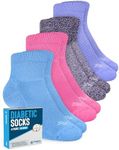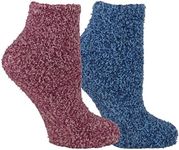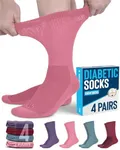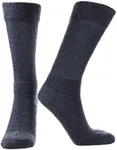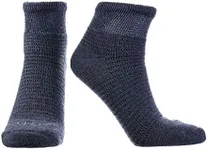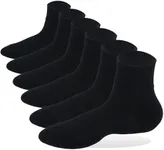Buying Guide for the Best Diabetic Socks For Women
When choosing diabetic socks for women, it's important to focus on comfort, support, and the specific needs of diabetic foot care. Diabetic socks are designed to reduce the risk of foot injury, enhance blood circulation, and keep feet dry. They are an essential part of managing diabetes and preventing complications. Here are some key specifications to consider when selecting the best diabetic socks for you.MaterialThe material of diabetic socks is crucial because it affects comfort, moisture control, and breathability. Look for socks made from materials like cotton, bamboo, or specialized synthetic fibers that wick moisture away from the skin. Moisture-wicking materials help keep feet dry, reducing the risk of fungal infections and blisters. If you have sensitive skin, hypoallergenic materials like bamboo can be a good choice. Choose a material that feels comfortable against your skin and suits your lifestyle needs.
Seamless DesignSeamless socks are designed to prevent irritation and pressure points that can lead to blisters and ulcers. This is especially important for people with diabetes, as they are more prone to foot injuries. When selecting diabetic socks, look for those with a seamless design to ensure maximum comfort and protection. If you have sensitive feet or have experienced issues with seams in the past, seamless socks are a must-have.
CushioningCushioning in diabetic socks provides extra comfort and protection for the feet. It helps to absorb shock and reduce pressure on the feet, which is beneficial for people with diabetes who may have reduced sensation in their feet. Socks with extra cushioning in the sole, heel, and toe areas can help prevent injuries and provide added comfort for daily activities. If you spend a lot of time on your feet or have a history of foot problems, look for socks with ample cushioning.
CompressionCompression socks help improve blood circulation, which is important for people with diabetes. They apply gentle pressure to the legs and feet, promoting better blood flow and reducing swelling. Compression levels can vary, with mild compression being suitable for everyday wear and higher levels for more specific medical needs. If you experience swelling or poor circulation, consider socks with mild to moderate compression. Always consult with a healthcare professional before choosing high-compression socks.
Fit and SizeProper fit and size are essential for diabetic socks to function effectively. Socks that are too tight can restrict blood flow, while those that are too loose can cause friction and blisters. Look for socks that offer a snug but comfortable fit, with enough stretch to accommodate any swelling. Many diabetic socks come in a range of sizes, so measure your feet and refer to sizing charts to find the best fit. If you have wide feet or specific foot conditions, look for socks that cater to those needs.
Moisture ControlMoisture control is a key feature of diabetic socks, as it helps keep feet dry and reduces the risk of fungal infections. Socks with moisture-wicking properties draw sweat away from the skin, keeping feet dry and comfortable. This is particularly important for people with diabetes, as excess moisture can lead to skin breakdown and infections. If you have sweaty feet or live in a humid climate, prioritize socks with excellent moisture control.
Antimicrobial PropertiesAntimicrobial properties in diabetic socks help prevent the growth of bacteria and fungi, reducing the risk of infections. These socks are often treated with antimicrobial agents or made from materials with natural antimicrobial properties. If you are prone to foot infections or want an extra layer of protection, look for socks with antimicrobial features. This can be especially beneficial for maintaining foot health and hygiene.




